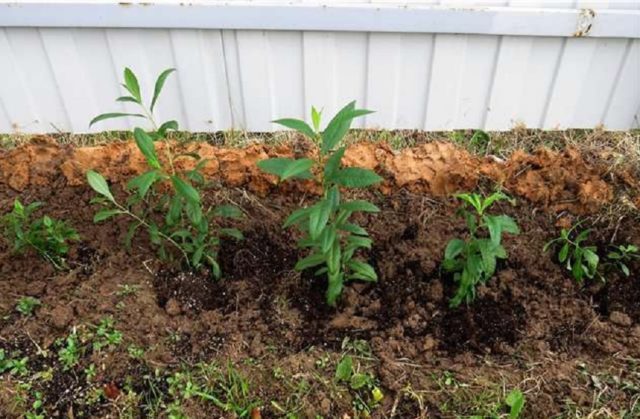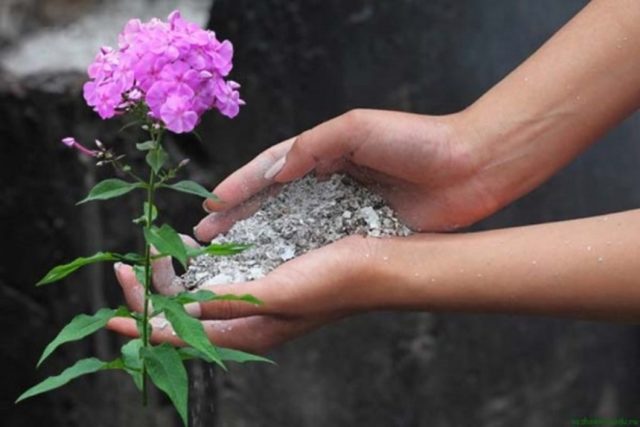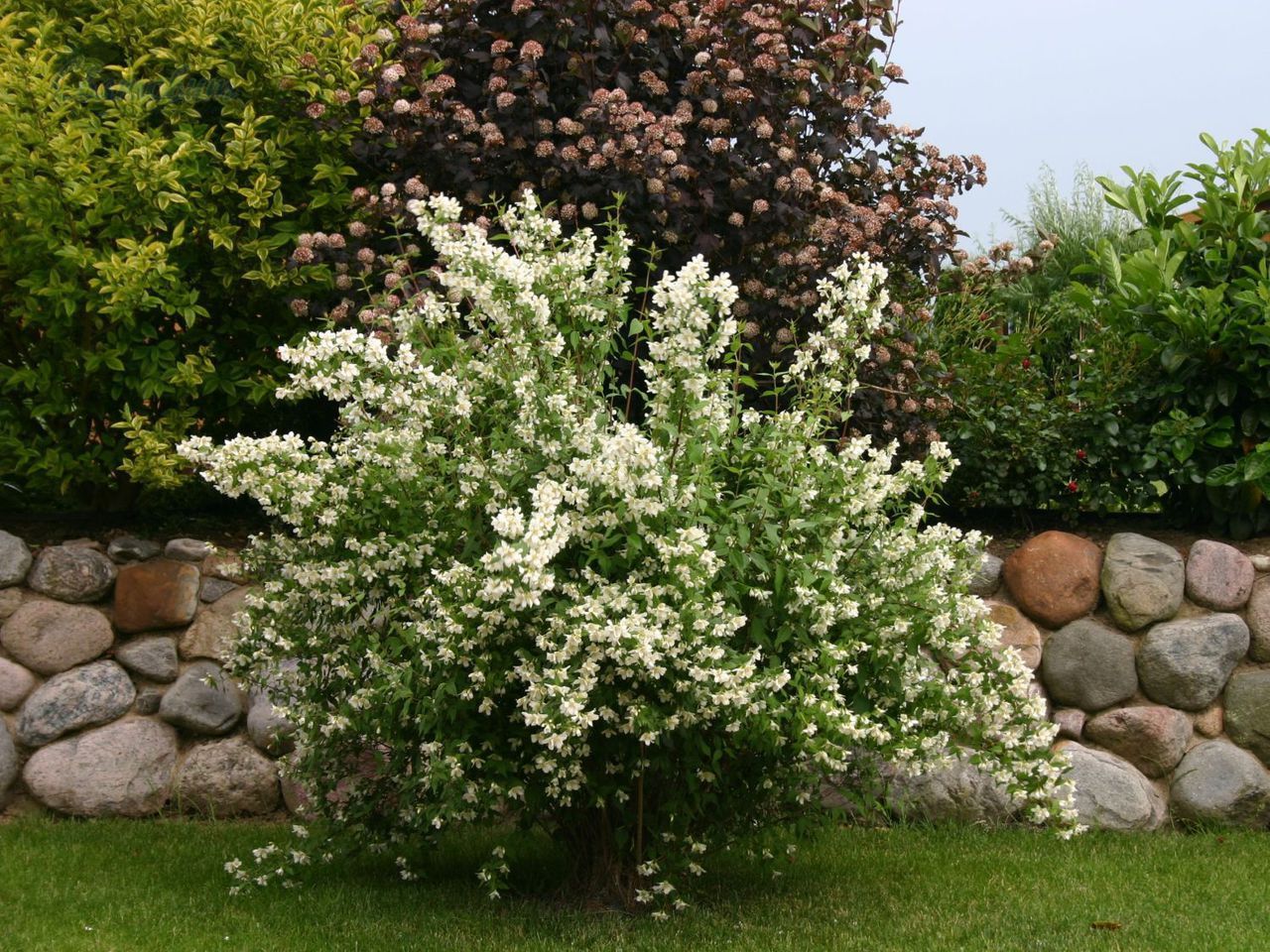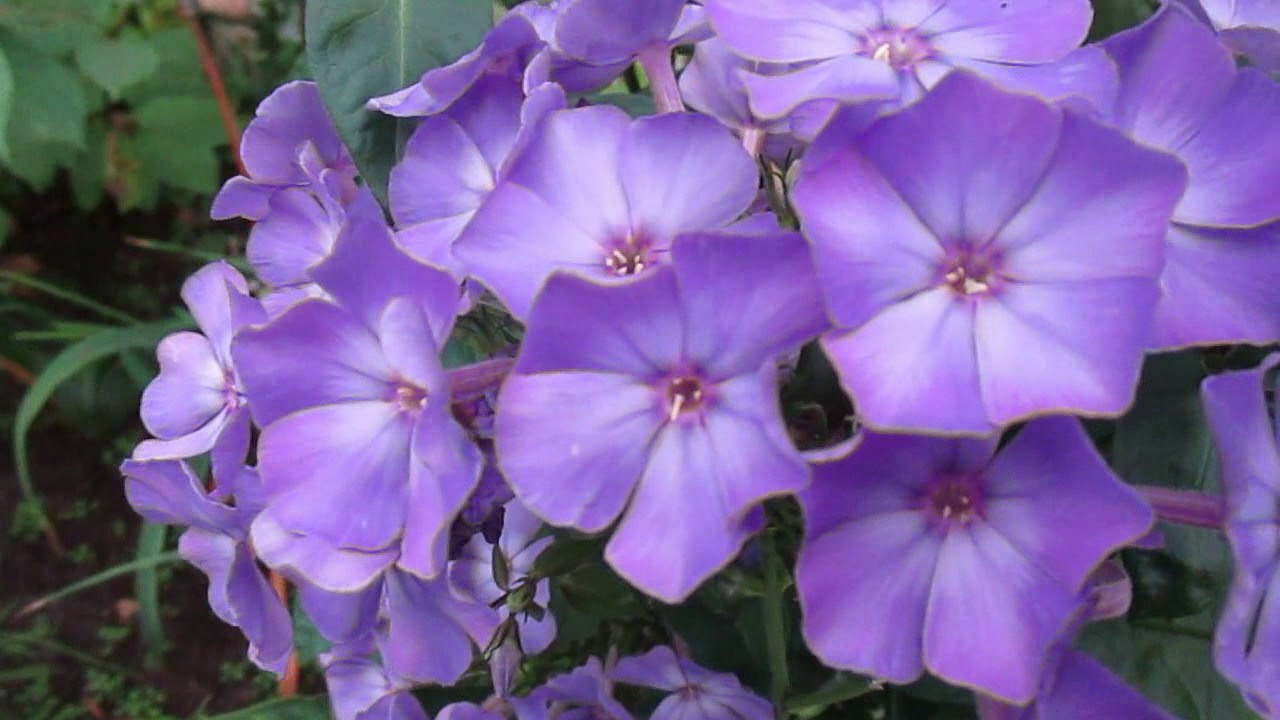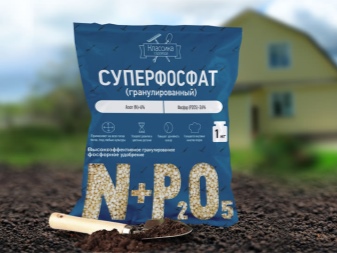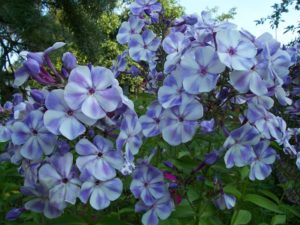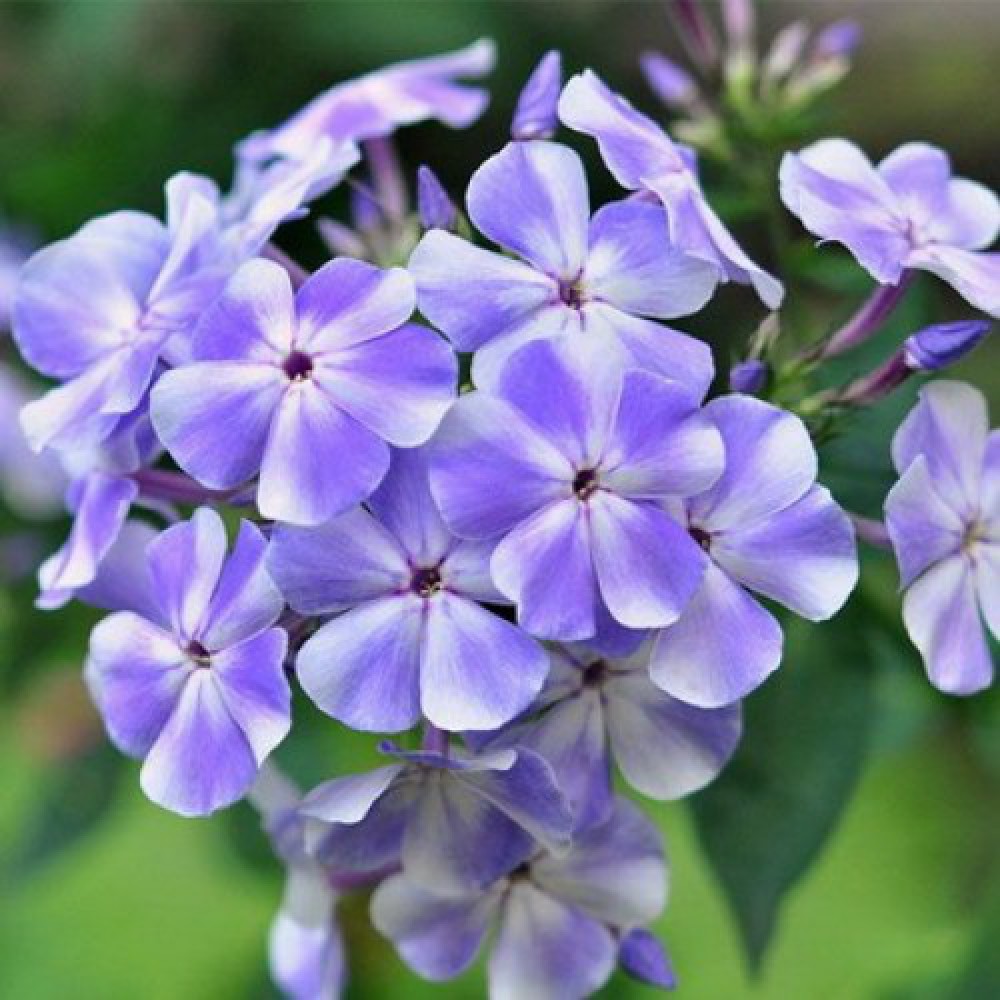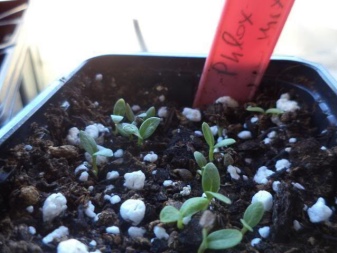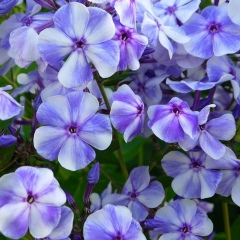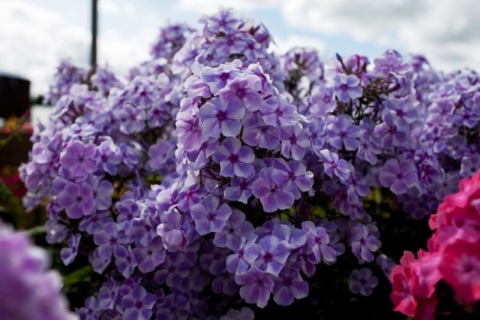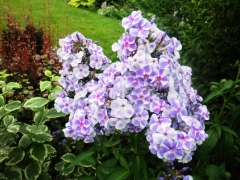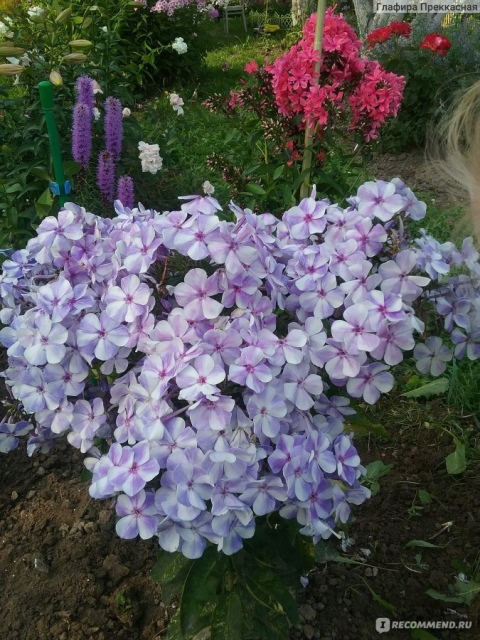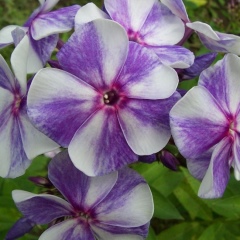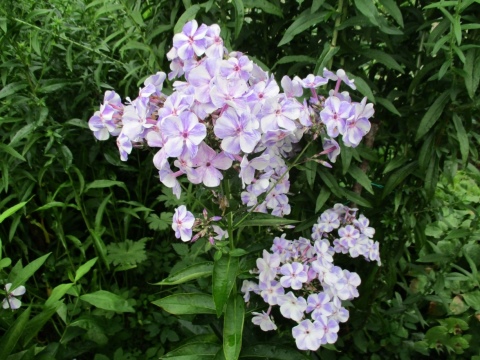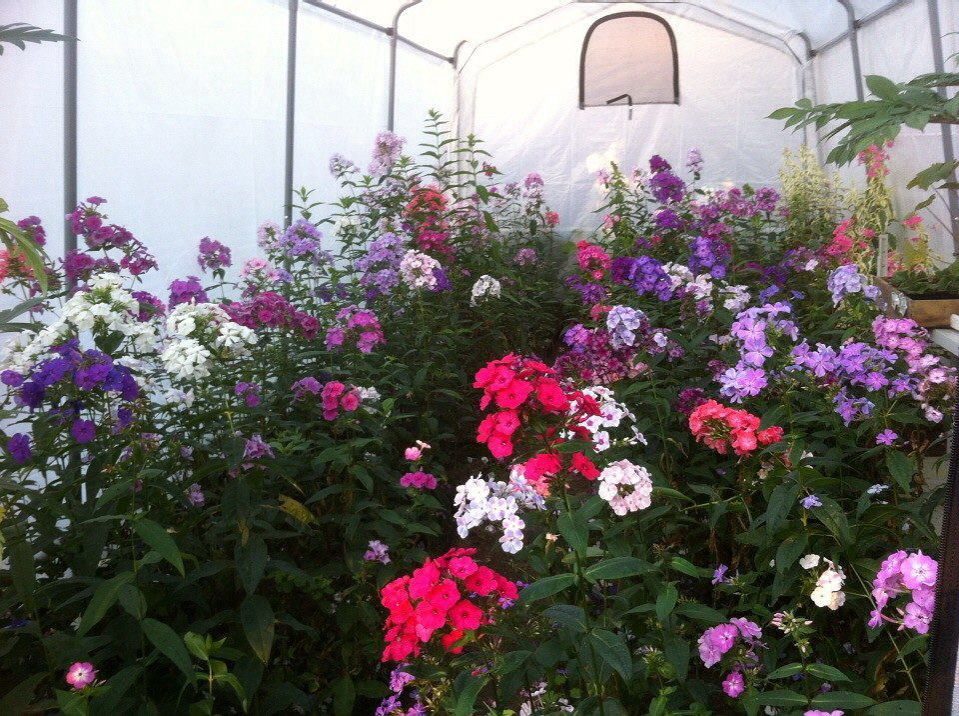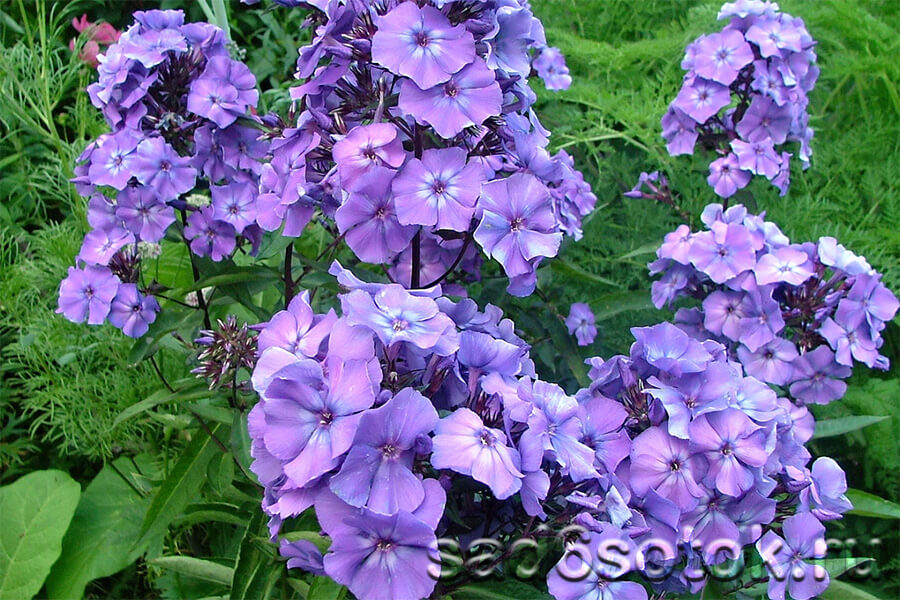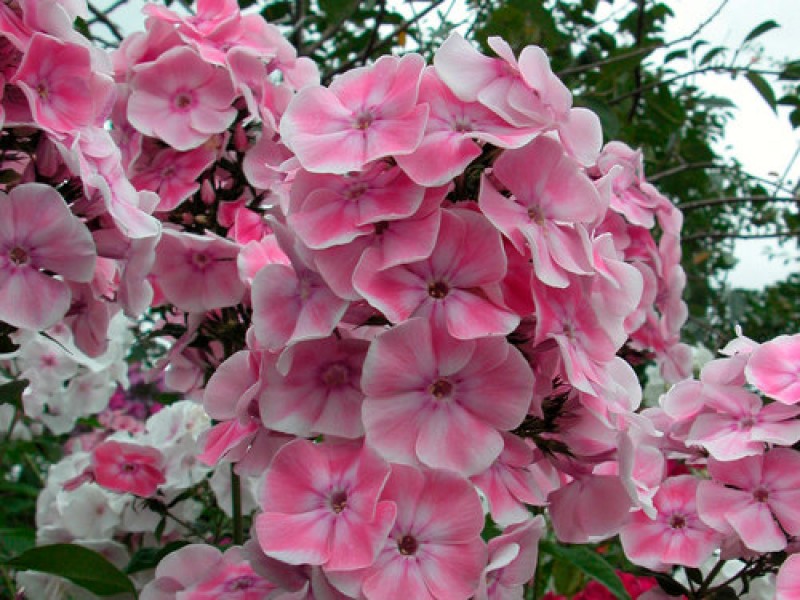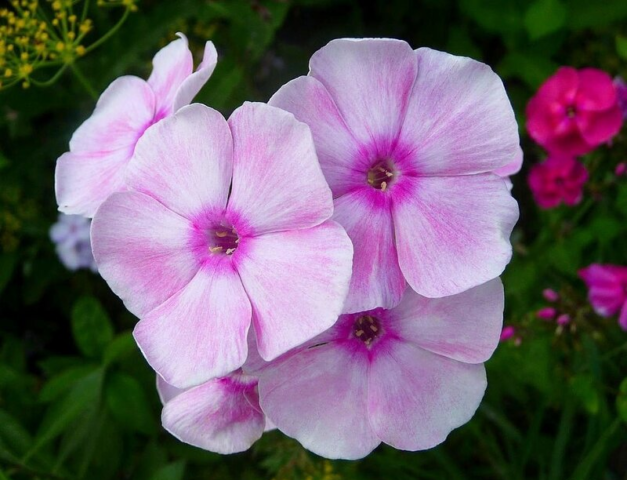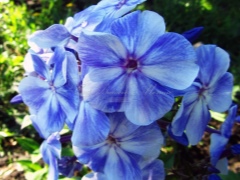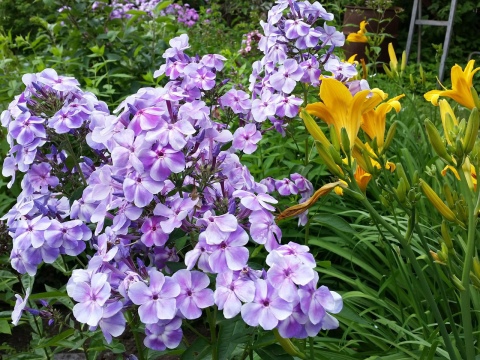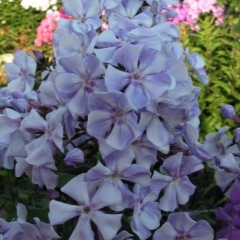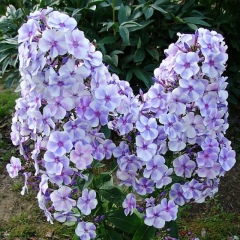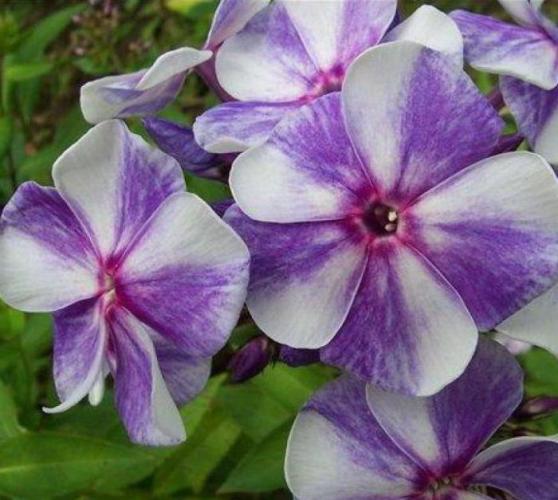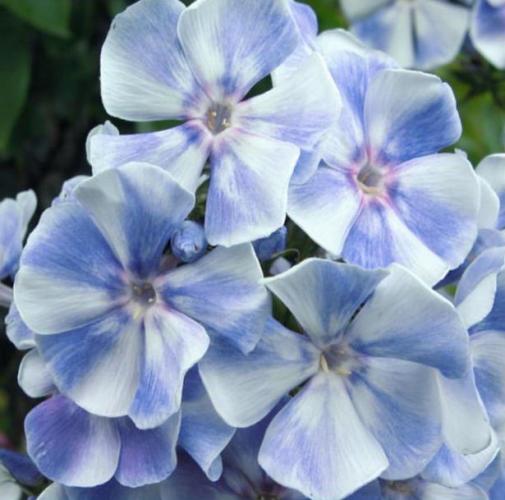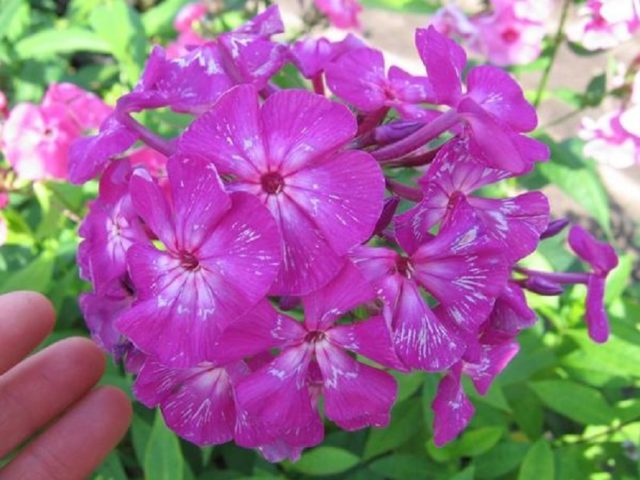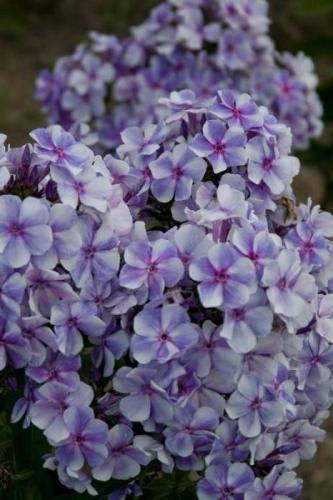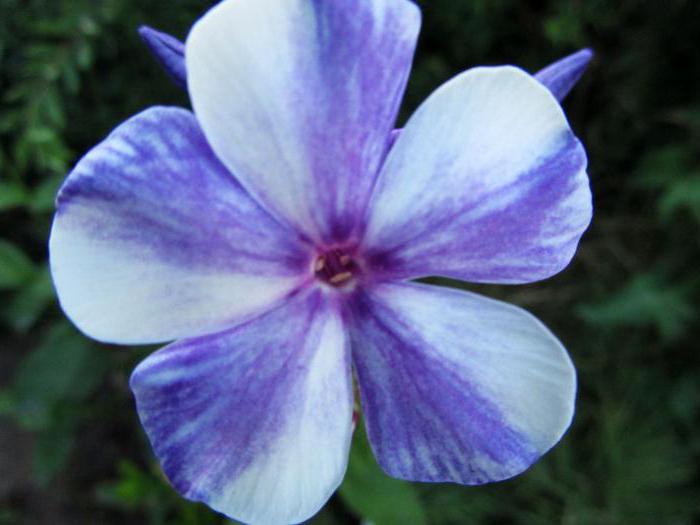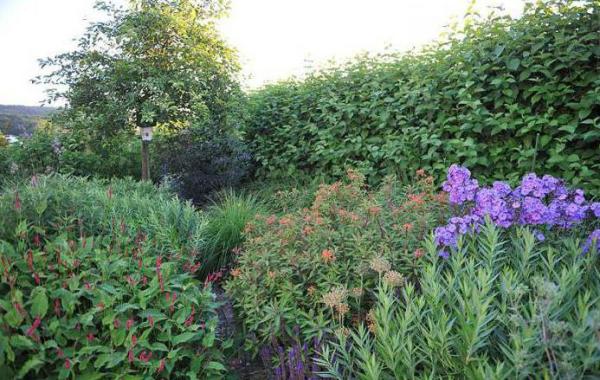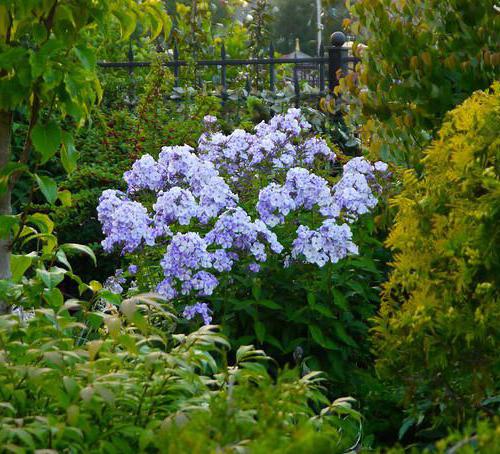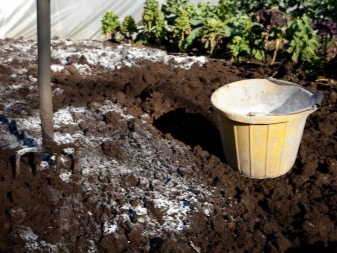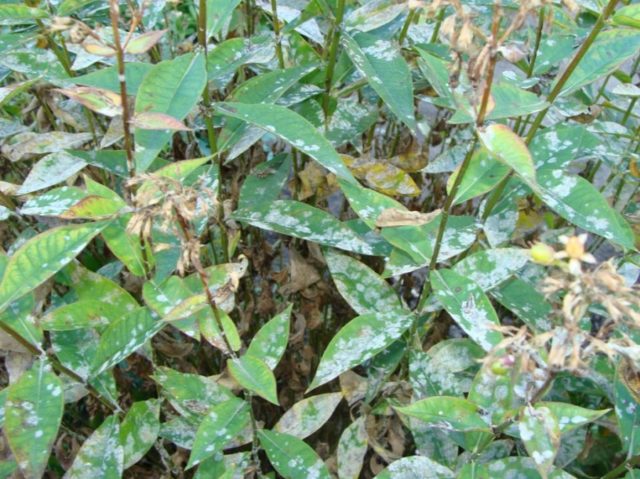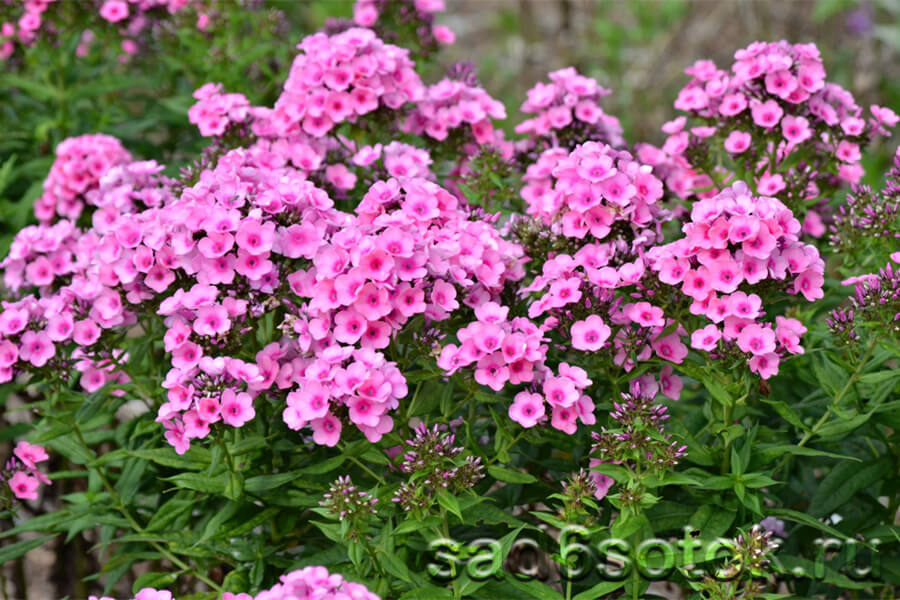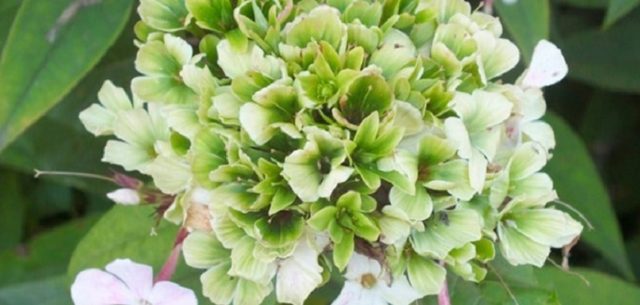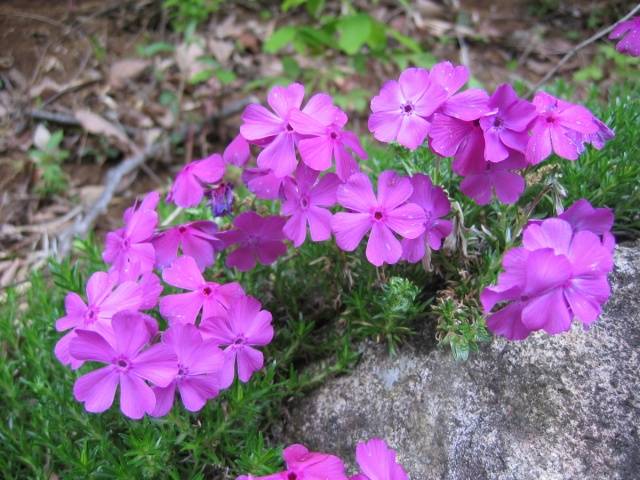Planting and leaving
Phlox paniculata do not belong to whimsical plants. They can develop on any soil composition, but a fully decorative look is possible only on a neutral composition, slightly acidic is allowed. If the soil is scarce, it is corrected by fertilizing the plant and planting it in a fertile substrate.
The culture is light-loving, but quite calmly responds to periodic shading. It is not recommended to set aside a place for paniculate varieties under large trees, on the north side, behind the wall of buildings and in a draft.
Important! For phlox paniculata, a place with stagnant water is unacceptable.
For planting, choose material with a healthy root system. The open root is placed in a growth stimulant and an antifungal agent for the time indicated in the instructions.
Sequence of planting works:
- 7 days before the procedure, they dig a hole 30 cm deep and wide.
- The bottom is covered with drainage and fertile soil consisting of compost, sand, sod layer with the addition of a complex mineral fertilizer.
- The depression is filled with water.
- On the day of planting, the substrate is loosened a little so that it is enriched with oxygen.
- Place the seedling in the center.
- The root collar is deepened by 2-3 cm.
- The soil around the bush is compacted and watered.
Important! If the work is carried out in the fall, the stems are cut so that no more than 10 cm remains above the surface.
After placing the paniculate phlox in the place of growth in the spring, the stems are not shortened.
Diseases and pests
Problems in the Gzhel variety can arise only when planting diseased seedlings or violation of agricultural cultivation techniques. It is recommended to first plant young phlox bushes on a separate bed, and after a certain time, place them in a permanent place. Gzhel can undergo diseases such as:
- Jaundice. The spread of this disease is slow. Symptoms are expressed in a change in the shape of the vegetative parts of the bush - stems, leaves, buds. If such signs are found, the plant will have to be destroyed. A change in the shape and color of flowers signals a disease of the bush.
- Variegation. It affects phlox during flowering. The bush loses its decorative effect, weakens. The plant must be destroyed, the planting site must be treated with fungicides. It is necessary to process phlox in a timely manner so that the disease does not deprive them of their decorative effect
- Powdery mildew. Another disease that will lead to the death of phlox. Preventive treatments with solutions of fungicidal preparations are required. A similar problem may arise if there are diseased plants of a different species on the site.
Aphids, slugs, spider mites may appear among pests. Most often they attack weakened phlox bushes after flowering. In this case, spraying with insecticides will help.
Planting phlox
Of course, phlox are light-loving flowers. But still, places with diffused light should be chosen for them. The direct rays of the sun literally burn out the petals, the flowers lose their charm and decorative appearance. A good protection for Gzhel phlox bushes will be the crown of tall bushes and trees. It is worth noting that this variety does not tolerate drafts, so it is worth choosing a place protected from them and winds.
The bushes do not differ in the presence of a developed root system, and therefore the soil for them should be prepared by digging it to a shallow depth - only 30-35 centimeters
In addition, it is important to create a fertile and permeable soil for the plant. If a sandy area was chosen for planting phlox, loamy soil and humus should be added to it
On acidic soils, Gzhel also feels uncomfortable, so before planting it is worth adding lime to the ground. Clay soil will require preliminary drainage - large crushed stone or broken brick must be laid in the planting pit.
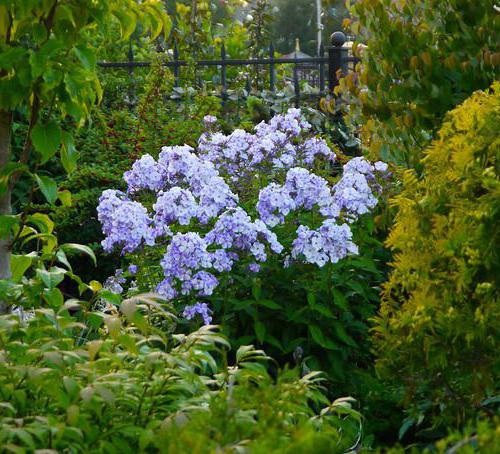
Planting and replanting phlox Gzhel is best in spring. However, the soil should be prepared in the fall!
Diseases affecting phlox
Usually, the cause of the defeat of phlox by various diseases is improper care of them or the acquisition of unhealthy seedlings. Experts advise making a quarantine bed on the site. It is on it that the "recruits" should be landed. Gzhel phlox should be placed in a permanent place only after there is no doubt about their health
It is also important to regularly clean all gardening tools, soil and plant containers. Some of the most popular treatments are steam, alcohol, and boiling water.
Diseases:
- One of the most common diseases affecting phlox is variegation. It usually appears during flowering. The disease can be determined by the symptoms: the color of the petals changes, asymmetrical radial stripes appear on them, which are lighter than the petals themselves. The presence of this virus leads to the fact that the plant looks weakened and ceases to please with its flowering. Affected phloxes should be dug up and burned. The landing site must be thoroughly disinfected.
- Phlox jaundice can cause the plant to reshape its leaves, stems and buds. The flowers will turn green, the plant will stop growing. Although this disease affects the plant slowly, the best way to combat it is by killing the bushes. But phlox can be saved with water solutions of antibiotics.
- Among the diseases affecting Gzhel, and powdery mildew. A white bloom appears on the plant, it lags behind in development and loses its attractive appearance. If you start the disease, phloxes can die. As a prophylaxis, a solution of furacilin and various fungicides should be used. If the disease has already appeared, it is necessary to repeatedly treat the bushes with preparations containing copper.
3D volume and rich color. A win-win option for novice florists.
Of course, the Russian collection of phlox will not leave anyone indifferent (here, like nowhere else - Russia is ahead of the rest), but sometimes you want something outlandish overseas.
I want to tell you about an interesting hybrid with a 3D-shaped flower - the Cleopatra paniculata phlox. The unique shape of such a lush and voluminous flower is created by additional layers of petals.
Cleopatra is very effective not only in its shape, but also stands out among others with a bright rich pink color of the corolla.
Such a flower will always rivet your attention.
I think the plant will blend beautifully in a group with blue, white, purple and violet flowers.
When I bought Kluopart, I read that the height of the flower is only 55 cm, so I planted it in the foreground of the flower garden. However, on my site, the beauty stretched out to 80-90 cm, somewhere at the level of Gzhel.
Another plus of the plant is its hardiness and excellent resistance to various diseases, including powdery mildew and spotting.
Flower diameter: 3.5-4 cm, "Cleopatra" blooms from June to the end of September.
The bush grows beautifully. I planted it last year, bought it from Search as a plant in a pot with one root.
The only drawback is that the bush is not upright, the stems seem to fall over, so the plant needs additional support.
It is better to plant this variety in an open sunny area, then the flowers will be large and fluffy.
Another important point, Cleopatra, like all phloxes, needs good watering, especially during the flowering period. And of course, she will gratefully accept any root and foliar feeding.
Cleopatra reproduces, like other paniculate phloxes - by dividing the bush, cuttings, layering.
Thanks to its unusual flower shape and colors, this novelty has become the queen of my garden!
You can enter the site via social networks:
Currency rates
Before using the filter, read the instructions. Filter on the plant species page.
The autumn season is open.
This autumn you can buy daylilies, hosts, astilbe and peonies in the nursery. Peonies, on the occasion of the completion of the theme, with a very decent discount. There are also very good (but temporary) discounts on well-grown varieties of other plants.
ATTENTION ! from August 26, the acceptance of orders is limited. Due to the large number of orders, all newly received orders will be fulfilled after already accepted
Botanical description
Phlox paniculata Uspech - phlox with large dense inflorescences of rich purple color with a brightly outlined white star in the middle grows up to 60-80 cm in height. Straight, strong stems form a compact shrub that grows quickly and forms a beautiful rounded shape due to dense oval-lanceolate leaves.
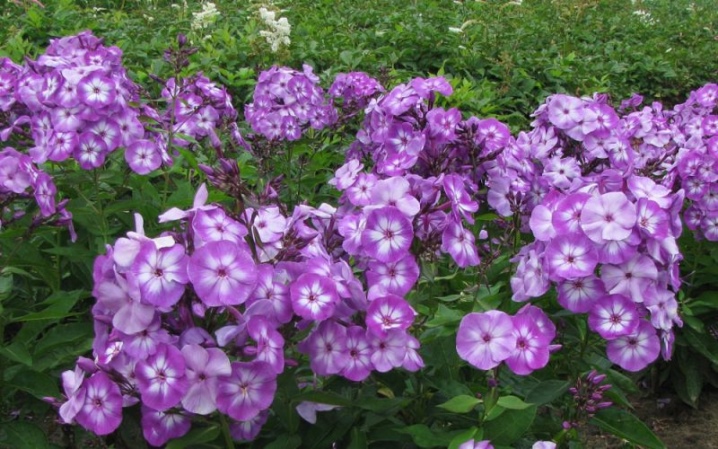
Flowers up to 4-4.5 cm in diameter do not fade, they are suitable for cutting and for growing in a flower bed. The root system is strong, vertical, up to 25 cm deep. They tolerate frost well and germinate at positive soil temperatures. The flowering period is from mid-July to late August.
The garden plant has high decorative qualities and is widely used for lawn decoration and use in landscape design.

Phlox Blue Perfume
Plants with this date of dispatch will be sent from April 1 to May 30 in the order of priority of receipt of orders.
Plants with only one delivery time are processed in one order!
For all planting material
Dozens of payment methods
Fast and convenient delivery
Russian Post (Moscow and the region within 24 hours), CDEK, Courier
| Height of an adult plant | 30 cm |
Phlox Blue Perfume (Blue Perfume).
Stems are thin, flexible, and form a loose sod. Flowering shoots rise vertically. The flowers are large, blue, with a delicate aroma. Flowering is long - 2-3 weeks, and so abundant that leaves are not visible. Shade-loving, but with sufficient watering, it feels good in the sun. Very hardy. Height - 20-30 cm.
Planting phlox: Planting phlox in the spring in the ground is carried out as follows: cuttings are planted in a prepared and loosened bed with a distance of 30 cm - this is what concerns low-growing varieties. High varieties must be planted at a distance of 50-60 cm from each other - they will need a lot of space. Immediately after planting, for a couple of weeks, the plants should be watered abundantly so that they take root and grow faster.
Phlox care: It comes down to regular watering, treatment from pests, and the introduction of complex fertilizers. Plants need feeding throughout the growing season, 5-7 feeding is carried out per season. The soil must be shed to the full depth of the root system. Watering is best done early in the morning or late in the evening. In no case should you water phlox with too cold water on a hot day, this can lead to burns of the plant and cracking of the stem. It is also undesirable for water to fall on the lower leaves when watering.
Soil for planting: The soil in a flower bed with phlox should be loose and nutritious - these are the two main requirements of the flower for the soil. The best option is loamy soil, which has a slightly acidic or neutral reaction. If the soil is acidic, it must be calcified before planting - otherwise phlox will not grow and bloom normally.
Winterizing: If the Blue Perfume phlox grows in the south, no shelter is required. But already, starting from the middle lane, it is desirable to provide plants with shelter for the winter. Before the onset of cold weather, phloxes are cut almost at the root, and the root circle is mulched with straw and other organic matter. Can be used for shelter and agrofibre, burlap.
Place for planting: Phlox Blue Perfume refers to unpretentious plants, but in order to achieve abundant and long-lasting flowering, you must choose the right place for planting them. It is best to plant the plants in a place protected from the wind. Phlox can grow both in partial shade and in the sun.
Reproduction of phlox by dividing the bush: Planting with a rhizome in spring is the best option, but sometimes the division procedure is carried out in early autumn (that is, before or after flowering). However, if there is a choice, gardeners recommend dividing the bush in the spring, since in this case there are more chances for the successful rooting of the delenka. Only mature bushes are divided - strong and healthy. The bush must be at least 4-5 years old. The procedure is as follows. The bush is dug out, trying to do without injuring it.
Quality assurance For the entire range
Variety characteristics
Gardeners admit: it is difficult to imagine a more spectacular variety of phlox than Gzhel. It pleases others with its color, creating the impression that the artist ran a large brush over the petals. Some of the petals have a delightful lavender hue, and some are snow-white. Together with the deep blue color of the core and light mother-of-pearl on the petals, this gives a truly magical effect. Even a simple description of Gzhel phlox is mesmerizing: lush cone-shaped inflorescences reach 25-30 centimeters in width! The aroma of flowers is also pleasing - you can catch spicy oriental notes in it.
Description of phlox Gzhel
The paniculate form of the flower is very decorative. The Gzhel variety was bred by the breeder Konstantinova E.A. in 2003. Since then, its popularity has remained at a high level, thanks to a whole list of positive characteristics. The flowering period of the bush is mid-early. Gzhel blooms in the middle of summer and pleases with its extraordinary color until the end of September. In the description of the paniculate phlox Gzhel, the main parameters of the plant are indicated:
- The height of the bush is 80-110 cm, the diameter is about 70 cm.
- The stems are strong, although rather slender.
- The root system is located close to the surface of the soil, branched along the sides.
- The variety forms buds in July. After blooming, they combine into dense inflorescences, resembling a cone in shape.
- Flowers with a diameter of 4-4.2 cm, the color of the petals is white or blue. Each has a purple eye. If you look at the plant from a distance, then the identity of the colors of the Gzhel painting is immediately striking. In addition, phlox flowers have a scent of oriental spices. Color saturation directly depends on weather conditions and time of day. During the heat period, a purple hue gains depth, cloudy days are distinguished by a rich blue. A brighter tone of phlox is gaining in the evening, in the morning the inflorescences look paler.
Important! Planting the Gzhel variety in too open areas of the garden should be avoided.
Intense sun exposure reduces its decorative effect.
Distinctive properties of the Gzhel variety are high winter hardiness, good immunity to diseases and crop pests. Perennial phlox survives well even winters with little snow, is not afraid of return frosts. Therefore, Gzhel can be grown in any region of Russia. Another significant advantage of phlox is its simplicity in leaving.
Description of phlox Gzhel Maxi
Breeders have made attempts to further improve the amazingly beautiful plant. In 2012, they introduced the Gzhel Maxi variety. The bush of this perennial is slightly lower, the maximum height does not exceed 75 cm. However, its inflorescences are formed by larger flowers. Their size reaches 30 cm, and the diameter of the flowers is 4.8-5.0 cm. Otherwise, the phlox of the Maxi variety is an analogue of Gzhel, with identical characteristics. It also has good disease, pest and frost resistance.
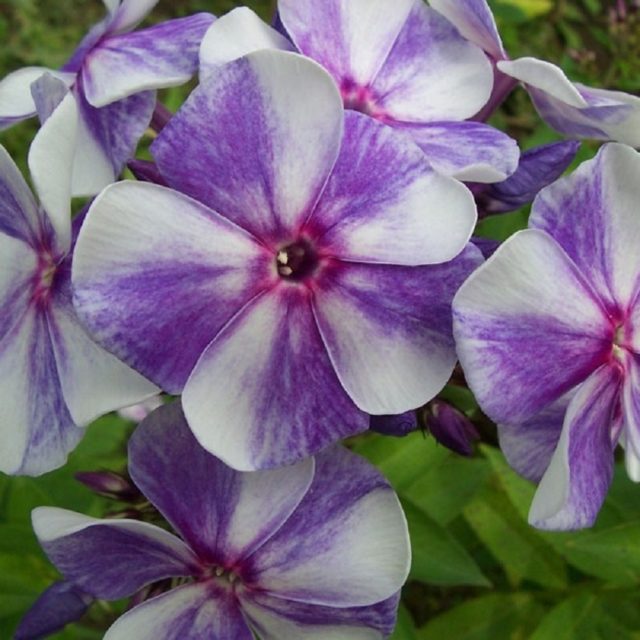
An improved variety should be planted to make the site look fabulous.


